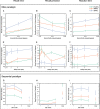A mechanistic insight into sources of error of visual working memory in multiple sclerosis
- PMID: 37937840
- PMCID: PMC10631758
- DOI: 10.7554/eLife.87442
A mechanistic insight into sources of error of visual working memory in multiple sclerosis
Abstract
Working memory (WM) is one of the most affected cognitive domains in multiple sclerosis (MS), which is mainly studied by the previously established binary model for information storage (slot model). However, recent observations based on the continuous reproduction paradigms have shown that assuming dynamic allocation of WM resources (resource model) instead of the binary hypothesis will give more accurate predictions in WM assessment. Moreover, continuous reproduction paradigms allow for assessing the distribution of error in recalling information, providing new insights into the organization of the WM system. Hence, by utilizing two continuous reproduction paradigms, memory-guided localization (MGL) and analog recall task with sequential presentation, we investigated WM dysfunction in MS. Our results demonstrated an overall increase in recall error and decreased recall precision in MS. While sequential paradigms were better in distinguishing healthy control from relapsing-remitting MS, MGL were more accurate in discriminating MS subtypes (relapsing-remitting from secondary progressive), providing evidence about the underlying mechanisms of WM deficit in progressive states of the disease. Furthermore, computational modeling of the results from the sequential paradigm determined that imprecision in decoding information and swap error (mistakenly reporting the feature of other presented items) was responsible for WM dysfunction in MS. Overall, this study offered a sensitive measure for assessing WM deficit and provided new insight into the organization of the WM system in MS population.
Keywords: binding; human; multiple sclerosis; neuroscience; resource model; swap error; working memory.
Plain language summary
Working memory is a system that temporarily stores and manipulates information used in tasks like decision-making and reasoning. Patients with multiple sclerosis – a condition that can affect the brain and spinal cord – often have impaired working memory, which can negatively affect their quality of life. Traditionally, working memory has been evaluated using tests that determine whether a patient can recall an item or not. In this approach, an incorrect response implies a complete absence of information regarding the specific item, resulting in a binary evaluation. More recently, researchers have shown that the precision of the memories people recall degrades gradually as they are asked to remember more things and that focusing on an item negatively affects recall precision for other items. This implies that working memory is reorganised flexibly between memorised items, a so-called ‘resource model’. Unlike previous research, which favoured a binary model, Motahharynia et al. used a resource model to study visual working memory impairment in multiple sclerosis. The study participants consisted of healthy volunteers and patients with two subtypes of multiple sclerosis. Each participant completed one of two different types of test. In one, they were shown targets for short periods of time and then asked to pinpoint their position after they disappeared. In the other, participants were asked to memorise the orientation and colour of consecutively presented bars. The findings confirmed that multiple sclerosis patients had worse memory recall than people without the disease. However, computer modelling provided insights into the sources of error in working memory dysfunction, showing that the memory deficiency was due to imprecision in recalling information and ‘swap errors’, the phenomenon of mistakenly reporting the property of other memorised items. This rise in swap errors is likely due to an increase in unwanted signals, or noise, in the brains of multiple sclerosis patients. Motahharynia et al. have presented a sensitive way of measuring working memory deficiency. Importantly, the measurements were able to distinguish between different stages of multiple sclerosis. This could help doctors detect disease progression earlier, allowing for more timely and effective treatment interventions. This method could also be useful in the development and testing of drugs for therapy.
© 2023, Motahharynia, Pourmohammadi et al.
Conflict of interest statement
AM, AP, AA, VS, FA, IA, MS No competing interests declared
Figures





Update of
- doi: 10.1101/2023.02.20.529229
- doi: 10.7554/eLife.87442.1
- doi: 10.7554/eLife.87442.2
References
-
- Badrkhahan SZ, Sikaroodi H, Sharifi F, Kouti L, Noroozian M. Validity and reliability of the Persian version of the Montreal Cognitive Assessment (MoCA-P) scale among subjects with Parkinson’s disease. Applied Neuropsychology. Adult. 2020;27:431–439. doi: 10.1080/23279095.2019.1565762. - DOI - PubMed
-
- Bays Lab Analogue Report Toolbox. Bayslab Computational Cognition Group. 2020 https://www.paulbays.com/toolbox/
Publication types
MeSH terms
LinkOut - more resources
Full Text Sources
Medical

